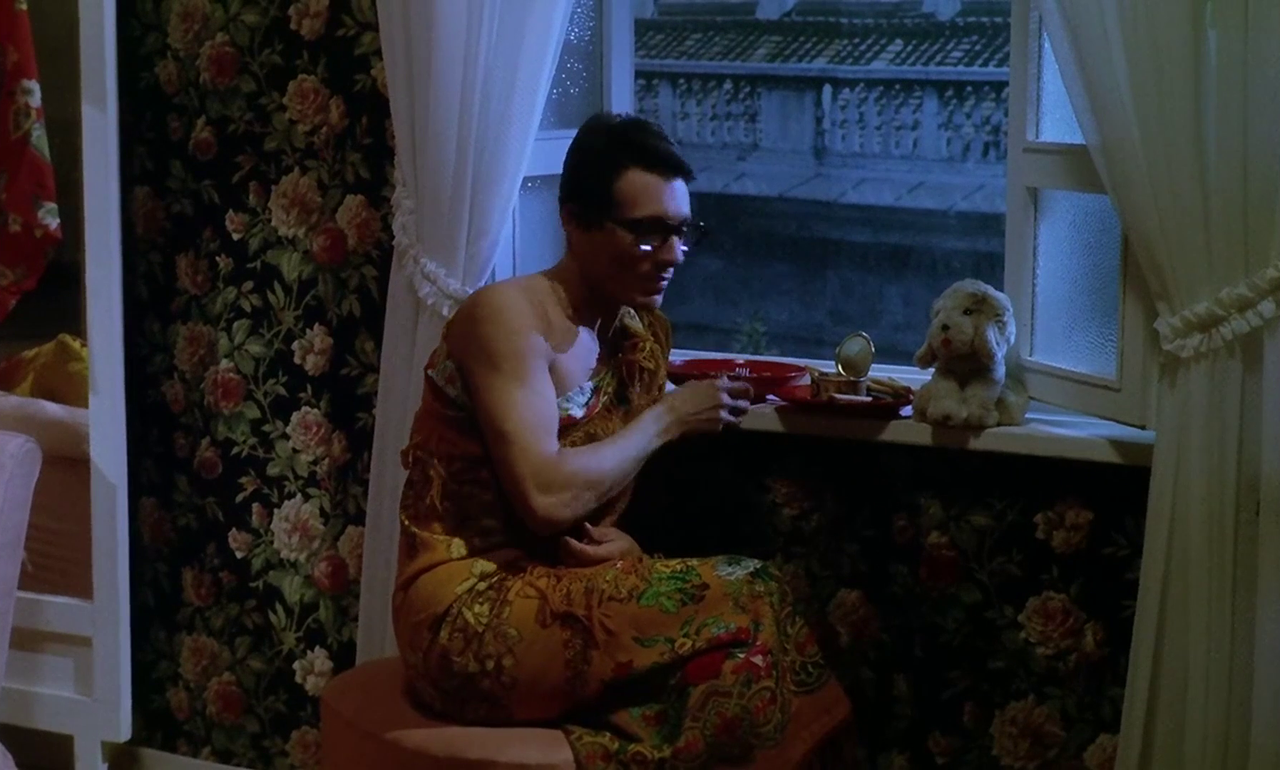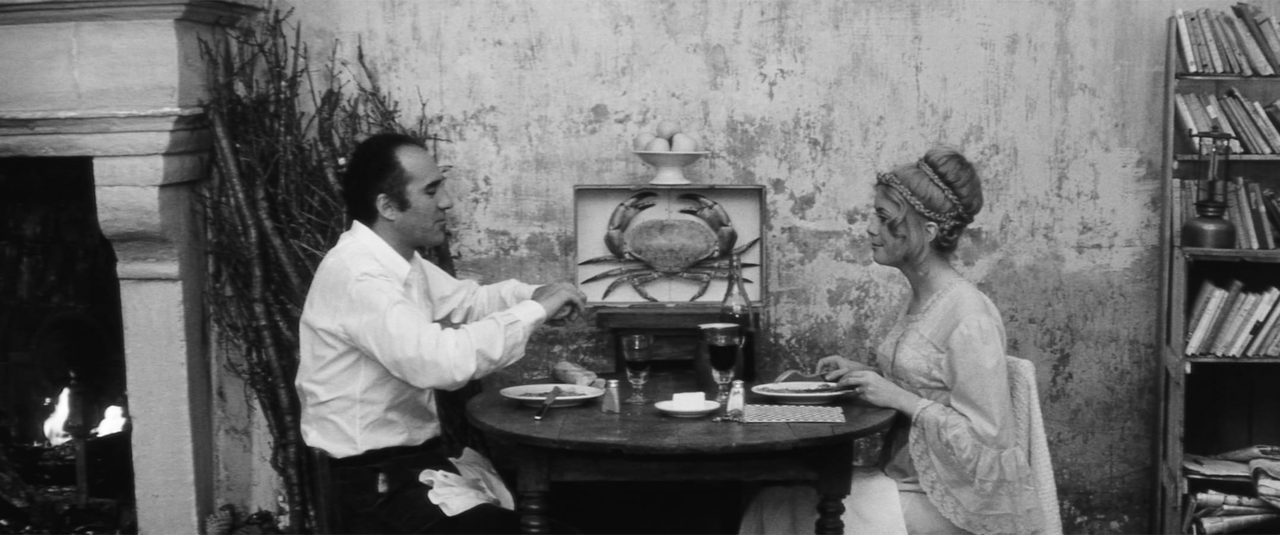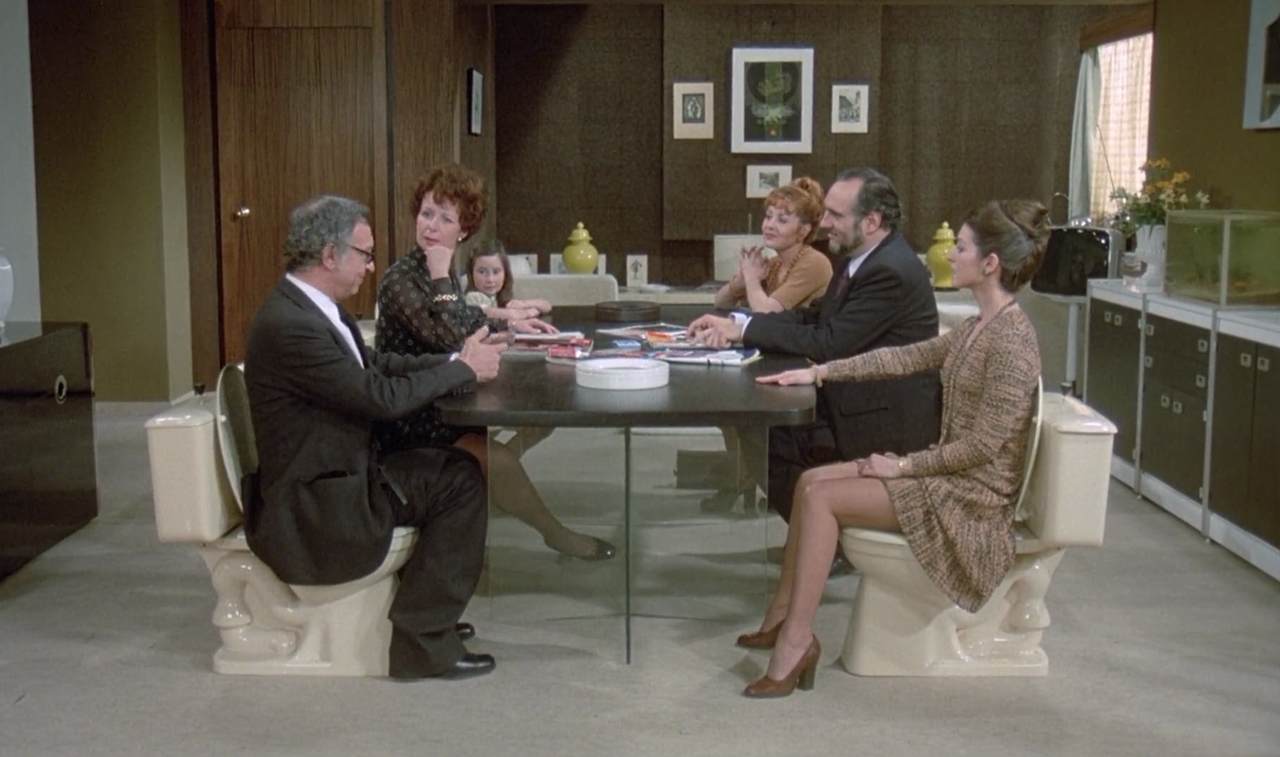“They pulled in just behind the fridge
He lays her down, he frowns
“Gee, my life's a funny thing
Am I still too young?”
He kissed her then and there
She took his ring, took his babies
It took him minutes, took her nowhere
Heaven knows, she'd have taken anything”Mauvais sang [Bad Blood / The Night Is Young] (Leos Carax, 1986)
Jan
8
David Bowie – 1947

(Alex) Denis Lavant in a scene set to David Bowie's Modern Love. DP: Jean-Yves Escoffier.
A [favourite] scene featuring a Bowie song for David Bowie's birthday (1947).
– David Bowie, Modern Love (from Let's Dance, 1983)
MichelPiccoli
“Whoever dies for the country hasn't lived in vain. I, on the contrary, will live for the country because I'm not that stupid.”Touche pas à la femme blanche [Don't Touch the White Woman!] (Marco Ferreri, 1974)
Nov
23
potato chips

Two white Frenchmen – in a University of Columbia and a CIA sweatshirt respectively – comment on the “period piece” they're in. CIA man (Paolo Villaggio) stuffs his face with potato chips. DP: Étienne Becker.
– George A. Custer
Compartiment tueurs [The Sleeping Car Murder] (Costa-Gavras, 1965)
Nov
8

Eliane Darrès (Simone Signoret) – comédienne, by herself – takes a long hard look at her table-set-for-two. DP: Jean Tournier.
Max et les ferrailleurs [Max and the Junkmen] (Claude Sautet, 1971)
Mar
16

Lily (Schneider) and Max (Piccoli) at a small table decked with good food, good wine, and quite a few wads of cash. DP: René Mathelin.
L'udienza [The Audience] (Marco Ferreri, 1972)
Nov
14

Amedeo (Enzo Jannacci), a young man with heavy rimmed glasses wrapped in heavy, flowery drapes as if it's a toga, eating late at night. There's an opened can on one of his plates. A sad looking stuffed toy dog hangs out. DP: Mario Vulpiani.
Les créatures [The Creatures] (Agnès Varda, 1966)
Aug
14

Edgar (Michel Piccoli) and Mylène (Catherine Deneuve) all dressed up for a home-cooked meal. On the wall behind them a huge framed mounted crab. DPs: Willy Kurant, William Lubtchansky & Jean Orjollet.
Dillinger è morto (1969)
Glauco (Michel Piccoli) finishing his copious dinner with half a watermelon. In his right hand the copy of the July 25, 1934 Chicago Daily Tribune with the headline CLEAR UP DILLINGER MYSTERY. DP: Mario Vulpiani.

July 31: watermelon on #NationalWatermelonDay
Dillinger è morto [Dillinger Is Dead] (Marco Ferreri, 1969)
Pow!
Industrial designer Glauco (Michel Piccoli) arrives home after a long long, tedious day. His wife Ginette (Anita Pallenberg) – in bed high on painkillers – cooked dinner but the dish is bland and long cold, and the maid (Annie Girardot) is already sleeping. Glauco decides to cook himself a gourmet meal. Looking for ingredients he finds a 1934 newspaper reporting the dead of Chicago gangster John Dillinger with inside of it a rusty 1930s revolver. Fascinated, he meticulously restores the handgun while preparing his meal.
Dillinger è morto is a story of food and alienation. Piccoli's Glauco, bored of his successful career, bored of his beautiful wife, bored of his beautiful house, finds sudden vigour in the act of preparing food and restoring an item that shouldn't be where it is and with that, essentially recreates John Dillinger's escape from Crown Point.
John Dillinger posing with a Tommy gun and the hand-carved wooden gun that he used to escape inescapable Crown Point jail on March 3, 1934. Crudely carved into the dupe's barrel are the words COLT 38.
#Bales2023FilmChallenge #MarcoFerreri #MichelPiccoli #AnitaPallenberg #AnnieGirardot #TeoUsuelli #MarioVulpiani #Italy #drama #crime #satire #food #1960s ★★★★☆
“Madrid was filled with the stench of – pardon my language – food. It was indecent.”Le fantôme de la liberté [The Phantom of Liberty] (Luis Buñuel, 1974)
Mar
9
World Kidney Day

Five adults and a child at a large table. They're all seated on toilets. One of the men is defecating. DP: Edmond Richard.
Eating is taboo, and relieving oneself is performed on a toilet at a communal table in Luis Buñuel's Le fantôme de la liberté. The farce strings together events from #Buñuel's life (who was 74 by the time he made this film), with dreams remembered by both Buñuel and co-writer Jean-Claude Carrière.
– le professeur des gendarmes
The title references the opening sentence from Marx and Engels' Communist Manifesto (1848): “A spectre is haunting Europe—the spectre of communism.”. What follows is a wonderful, free-flowing pastiche performed by a sublime cast.
“If she is innocent! Why do you never wonder if Parris be innocent, or Abigail? Is the accuser always holy now? Were they born this morning as clean as God's fingers? I'll tell you what's walking Salem — vengeance is walking Salem. We are what we always were in Salem, but now the little crazy children are jangling the keys of the kingdom, and common vengeance writes the law!”Les sorcières de Salem [The Witches of Salem / The Crucible] (Raymond Rouleau, 1957)
Mar
7
National Town Meeting Day

The townspeople meet in the barn to judge the accused. DP: Claude Renoir.
Raymond Rouleau's Les sorcières de Salem – with a screenplay by Marxist philosopher Jean-Paul #Sartre – is a very early film adaptation of Arthur Miller's 1953 #TheatrePlay The Crucible. An allegory of #McCarthyism, the play is a (partially dramatised) retelling of the #SalemWitchTrials, a dramatic episode in early US-American history. During several court and town meetings, 200 people were falsely accused of meddling with the Devil; 19 of them were eventually executed.
– Arthur Miller, The Crucible (1953)
Miller himself was accused of un-American activities in 1956 and convicted of contempt of Congress for refusing to identify others present at meetings he had attended. Which doesn't mean that #WitchTrials are a thing of the past. As easily one can transplant Puritan religious mass hysteria to 1950s McCarthy anti-socialism, as easy is it applicable to the state of the world today.
